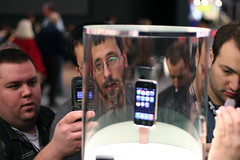Roy, a doorman for my apartment building, stopped me this morning to chit chat. Knowing my affection for all new mobile phones, I wasn’t surprised that he asked to play around with my Nokia N95. “Are you going to buy the iPhone?” he asked, seeking a second opinion since he has already made up his mind and is going to buy an iPhone.
 Though he doesn’t have an iPod right now, he thinks an iPhone would give him two devices in one, despite the high price tag. He is seemingly undeterred by the questionable battery life. (One of the reasons why I have a more wait-and-see attitude towards this Apple device.) He isn’t the only one - as the interest in iPhone seems to be on an upswing.
Though he doesn’t have an iPod right now, he thinks an iPhone would give him two devices in one, despite the high price tag. He is seemingly undeterred by the questionable battery life. (One of the reasons why I have a more wait-and-see attitude towards this Apple device.) He isn’t the only one - as the interest in iPhone seems to be on an upswing.
Even if you disregard the rumors and fan sites - the population at large seems to have a considerable interest in the iPhone, indicated by the total search volume for keyword “iPhone.” According to Hitwise, a research group that tracks Internet traffic trends, iPhone related searches represent over 0.002% of total Internet searches per week for past three weeks, with iPhone release date and price being the specific information folks are looking for. (In comparison, MySpace was the #1 query and had 1.16% of the total search volume.) Just as an unscientific indicator the search volume is a good indicator of increasing commercial appeal of the device.
The big question, however, is how does iPhone impact the wireless market at large — and whether it will result in a market share shift, putting AT&T at an advantage.
AT&T is betting big on this device and is hoping to pull ahead of its rivals by riding the iPhone express. AT&T and Apple are going to be launching a big media blitz to promote the iPhone, and according to UBS Research, it will be a major reason why AT&T will be able to add approximately 2.8 million gross postpaid subscribers in the third and fourth quarters of 2007.
If Apple’s guidance of 10 million units in 18 months hits the target, UBS estimates that 2 million iPhones will be sold in the U.S. in the first six months of the launch. That works out to about 18% of AT&T’s post-paid additions and upgrades, UBS estimates. But these 2 million will have to come from somewhere - probably switchers from other wireless services.
At the end of Q1 2007, there were about 170 million postpaid wireless subscribers in the U.S., with Verizon the largest carrier (56 million) with AT&T at #2 with about 51 million, followed by Sprint (41 million) and T-Mobile bringing up the rear at 22 million. (These numbers don’t reflect wholesale and prepaid customers.)
So 2 million units don’t mean much in market share — a little 1.1% market share gain for AT&T in the first six months, but it is the residual impact that might cause the big upheaval in the wireless market.
There are some who believe that since iPhone isn’t going to get as much subsidy as other devices, AT&T can pass those subsidies to even further subsidize non-Apple phones, and making its service more attractive. That would be one way to capture the increased foot traffic to AT&T stores.
Will Verizon and Sprint take this lying down? Of course not, and will launch their own price subsidies, discount plans or whatever it takes to hang on to their subscribers. And whatever happens, consumers will come out ahead — nothing wrong with that. And even if Roy doesn’t end up buying the iPhone, he still might get a good deal somewhere else.


No comments:
Post a Comment